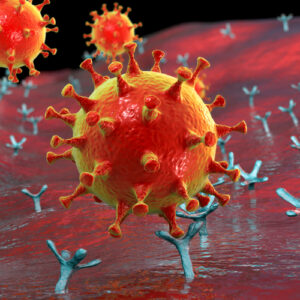Paramyxovirus Receptors
The Native Antigen Company manufacturers highly purified Paramyxovirus receptors using state-of-the-art expression and purification techniques. On request we can also undertake custom preparation of recombinant and native proteins for a broad range of disease states.
Paramyxovirus Receptors Background
Paramyxoviruses are negative-sense, single-stranded RNA viruses whose members include Rubulavirus, Avulavirus, Respirovirus, Pneumovirus, Henipavirus and Metapneumovirus. Paramyxoviruses cause a variety of human diseases including mumps, measles, which caused around 733,000 deaths in 2000 and respiratory syncytial virus (RSV), which is the major cause of bronchiolitis and pneumonia in infants and children. The human parainfluenza viruses (HPIV) are the second most common causes of respiratory tract disease in infants and children. More recently, Hendra virus (HeV) and Nipah virus (NiV) in the genus Henipavirus have emerged in humans and livestock in Australia and Southeast Asia. Both viruses are contagious, highly virulent, and capable of infecting a number of mammalian species, causing potentially fatal disease.
The virions of this family consist of a lipid envelope surrounding a nucleocapsid, and the envelope is derived directly from the host cell plasma membrane by budding, and contains two or three transmembrane glycoproteins. Virions attach via these glycoproteins to cellular sialoglycoproteins or glycolipid receptors. The F protein then mediates fusion of the viral envelope with the plasma membranes at physiological pH. The liberated nucleocapsid remains intact, and all three associated proteins (N, P, and L) are required for the transcription of the incoming viral genome. Paramyxoviruses replicate within the cytoplasm of infected cells.
The capacity of an attachment glycoprotein to specifically target receptors expressed on the host cell surface is a critical determinant of paramyxoviral host tropism. Paramyxovirus attachment glycoproteins are type-II membrane proteins composed of an N-terminal cytoplasmic and transmembrane region, a stalk domain, and a receptor-binding domain. The receptor-binding domain forms a six-bladed β-propeller fold and is the key determinant of host receptor specificity. These glycoproteins have been divided into three major groups: hemagglutinin (H), hemagglutinin-neuraminidase (HN), and attachment glycoproteins (G).
Cell surface receptors utilized by paramyxoviruses can be either protein or carbohydrate. HN glycoproteins encode a structurally well-conserved binding motif, which recognizes sialic acid (N-acetylneuraminic acid), a terminal saccharide present on cellular glycoproteins and glycolipids. Because of the abundance of sialic acid at the cell surface of vertebrates, it is likely that factors other than receptor specificity may play a major role in the host tropism of HN-bearing viruses. H and G glycoproteins, on the other hand, recognize proteinaceous cell surface receptors, such as SLAM/F1 (signaling lymphocytic activation molecule family member 1, CD150) and nectin-4 for morbilliviruses and ephrinB2 and ephrinB3 for NiV and HeV. Henipaviruses exhibit a broad host range, with natural infections observed in bats, horses, pigs, cats, dogs, goats, and humans. The usage of the cell surface receptor ephrinB2, which is highly conserved across vertebrate species, is associated with the wide host tropism. Moreover, the expression of ephrinB2 on range of cell types allows for their efficient systemic dissemination. NiV was included in the World Health Organization (WHO) list of the seven pathogens it deems most require urgent research and development in order to mitigate potential public health emergencies.
References
- Zeltina et al. (2016) Emerging Paramyxoviruses: Receptor Tropism and Zoonotic Potential. PLoS Pathog 12(2).
- Dutch RE (2010) Entry and Fusion of Emerging Paramyxoviruses. PLoS Pathog 6(6).
- WHO. Annual review of diseases prioritized under the Research and Development Blueprint. 6-7 February 2018 Geneva, Switzerland.
Paramyxovirus Receptors
We are pleased to offer this highly purified cell surface receptor protein shown to be used by a wide range of Paramyxoviruses.
Questions?
Check out our FAQ section for answers to the most frequently asked questions about our website and company.

